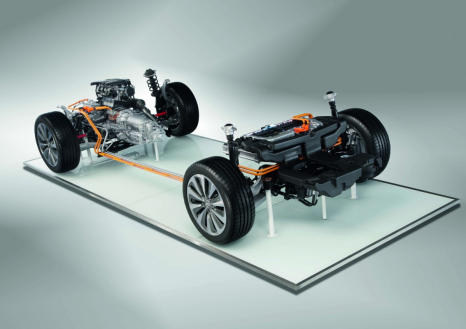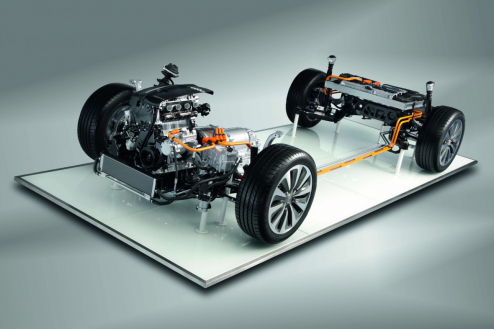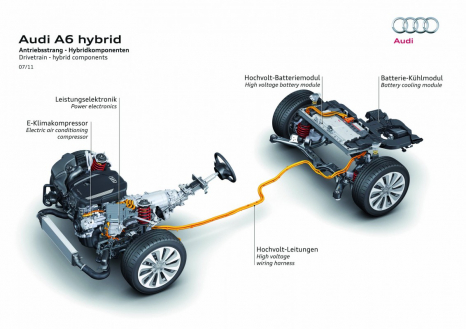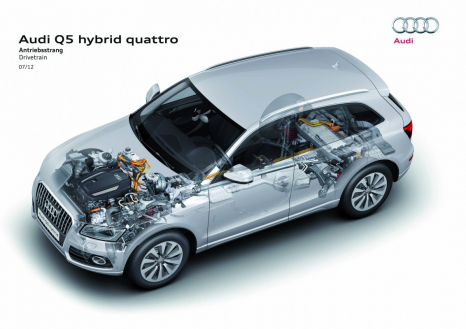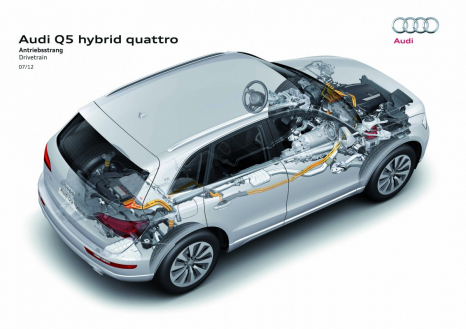Hybrid technology
Audi offers full hybrids with lithium-ion batteries in three vehicle classes. The A6 hybrid (Combined fuel consumption in l/100 km: 6.2; Combined CO2-emissions in g/km: 145)**, the A8 hybrid and the Q5 hybrid quattro (Combined fuel consumption in l/100 km: 6.9; Combined CO2-emissions in g/km: 159)** use a parallel driveline – a highly efficient concept.
The parallel driveline that Audi uses in its current hybrid models is a highly efficient concept with a modular construction. The only difference across the three models – Audi Q5 hybrid quattro, A6 hybrid and A8 hybrid – is that the SUV features all-wheel drive, while the power is transmitted to the front wheels only in the sedans. Total system output is 180 kW (245 hp), while overall torque stands at 480 Nm.
Drive is handled by a 2.0 TFSI with 155 kW (211 hp) and an electric motor with up to 40 kW and 210 Nm of torque. The power from both units is transmitted by an extensively modified, eight-speed tiptronic without a torque converter. In its place is the disc-shaped electric motor combined with a multi-plate clutch, which forms the connection between the motor and the TFSI. It operates precisely, smoothly and quickly in all situations.
The energy storage medium is a lithium-ion battery system that weighs just 36.7 kilograms; it has an energy rating of 1.3 kWh and an output of 39 kW. Depending on requirements, it can be air-cooled in one of two ways – via air extracted the from the vehicle interior or via a cooling system coupled to the air conditioning.This technology maintains the battery temperature within the required limits across a wide range of scenarios and facilitates a electric range of up to three kilometers at a constant speed of 60 km/h. The top battery-powered speed of 100 km/h also sets a new benchmark.
The compact and lightweight power electronics, which are water-cooled like the electric motor, convert the direct current from the battery into alternating current. The power electronics have an integrated DC converter that connects the electric components on the 12-volt vehicle network to the high-voltage network.
The brake servo unit is also supplied by an electric vacuum pump; a complex control strategy adapts the braking process to electric driving and energy recuperation. The air conditioning compressor has an electric drive, while an electric auxiliary heater rounds of the heating system. In the final reckoning, the hybrid-specific components add less than 130 kilograms of extra weight.
The three hybrid models are as refined as they are efficient. The sprint from zero to 100 km/h takes between 7.1 and 7.7 seconds, while top speed stands at between 225 and 240 km/h. Average fuel consumption is just 6.2 to 6.9 liters per 100 kilometers – equating to CO2 emissions ranging from 145 to 159 grams per kilometer.**
The three Audi hybrid models can run on the engine alone, on electric drive only and in hybrid mode; they can also recuperate energy while braking and provide boost under high load – which means both units running together. The driver can select from three programs – the EV mode gives priority to electric drive, program D provides efficient control for both power units and S mode is set up for sporty driving.
The most important display instrument is the power meter. Its needle presents the total system output on a scale charge status. In parallel, the color display of the driver information system and the monitor of the MMI Navigation plus present the power flow and operating conditions in the form of elegant graphics.
Audi can look back on more than 20 years of experience in hybrid technology. The first generation of the Audi duo – a technology study based on the Audi 100 Avant – made its debut as far back as 1989. A five-cylinder gasoline engine drove the front wheels, while a nine-kilowatt electric motor provided power to the rear wheels as required. The energy storage medium was nickel-cadmium batteries. A second duo variant based on an Audi 100 Avant quattro followed two years later.
In 1997, Audi became the first European automaker to put a hybrid vehicle into low-volume production – the Audi duo based on the A4 Avant. It was driven by a 1.9-liter TDI with 66 kW (90 hp) and an electric motor with 21 kW fed by a lead gel battery in the rear. Both units sent their power to the front wheels.
Like both of the previous studies, the low-volume duo was based on the plug-in concept. Its battery could be charged from an electricity outlet and the motor was able to recover energy during deceleration. Running on battery power, the Audi duo reached a top speed of 80 km/h and 170 km/h with the TDI unit.
**Figures depend on the tires/wheels used.
Status: 2012
